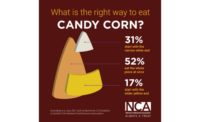Twisting traditions

 At first, it seems like chocolate-covered natural licorice would be, well, unnatural. But once you take a bite of Lucky Country’s newest offering, you realize immediately that this was exactly the pairing natural licorice has been waiting for.
At first, it seems like chocolate-covered natural licorice would be, well, unnatural. But once you take a bite of Lucky Country’s newest offering, you realize immediately that this was exactly the pairing natural licorice has been waiting for.
The treat, available in black licorice covered in dark chocolate and strawberry licorice covered in either dark or milk chocolate, has a chewy center that tastes better than a gummy paste and chocolate coating that makes it taste gourmet.
And, lest you think this is a one-time thing, New Zealand Natural Goods also now sells a similar product under it’s RJ’s licorice line, licorice-covered chocolate, which comes in black and raspberry licorice flavors.
The rush to pair licorice with chocolate is just one of the new ways companies are innovating to sell the old-fashioned treat.
And it seems to be working. Overall, sales of licorice are up 6.56% since last year, as the category raked in about $359 million, according to data from Symphony IRI, a Chicago-based research firm.
Likely a large factor in the category’s growth is the American consumer’s new-found love of natural licorice — which offers a more intense flavor and a softer texture than the traditional licorice candies sold in the United States. In fact, six of the top 20 selling licorices are natural licorice, Symphony IRI reports.
American Licorice, known mostly for it’s Red Vines, launched Natural Vines in late 2010, and Spokesman Michael Kelly says the product has been the company’s fastest growing ever in terms of trajectory.
“It’s doing very, very well. It’s out performing a lot of players,” he says. “It’s growing very quickly.”
Meanwhile, Raewyn Epps, with New Zealand Natural Goods, says her company’s natural licorice line, RJ’s licorice, continues to thrive as well.
“While some are looking for an all-natural confection product, others are just looking for a great quality, great tasting licorice and it is an added benefit that it contains all-natural ingredients,” she says.
As natural licorice draws in consumers, companies are coming up with flavors that go beyond the traditional black licorice and strawberry to keep their line-up fresh.
For example, Lucky Country makes blueberry with acai, pomegranate, mango and now, even a marionberry flavored licorice.
“[Marionberry] has done so well that it has quickly competed with our strawberry for second in rate of sales,” says Rhonda Sigmon, the company’s sales and marketing manager.
She says natural licorice is flourishing because consumers are becoming more aware of what they’re eating.
“[They] enjoy the taste and texture of a product that is low in fat as well as made from natural ingredients,” Sigmon explains. “We see continued growth within our natural line and are making more new flavors to meet the demands of our customers.”
All this doesn’t mean more traditional consumer licorice, such as Hershey’s Twizzlers or American Licorice Co.’s Red Vines aren’t still very popular though. The two continue to be ranked first and second in the category respectively.
But neither brand is resting on it’s laurels.
Twizzlershas seen success with it’s Pull N’ Peel licorice, which is ranked third over all in the category. Meanwhile, American Licorice successfully introduced Cherry Vines and re-launched Grape Vines, now the number 16 top-selling licorice.
“Grape Vines is already outselling the black licorice variety of Red Vines,” Kelly says. “It really answers this sort of desire for retro inspired products and grape is obviously a very popular flavor across all candies. It’s something that people were asking for.”
Of course, as the category continues to attract consumers, more stores are trying to get their share of the profits.
Kelly says he’s seen an increased presence on store shelves by private label offerings, and it’s a trend he believes will continue.
In fact, Symphony IRI reports that private label licorice sales have increased about 27% over the last year, to $9.4 million.
The ongoing success in the category over all no doubt will lead both brand-name and private label companies to continue attempting to innovate the next big thing in the licorice category in hopes of gaining their share of the growing profits. Caramel-covered licorice anyone?
Can you really overdose on black licorice?
Nobody wants to hear that a beloved candy treat could land them in the hospital, but that’s exactly what a U.S. government agency warned late last year when it claimed too much black licorice could cause health problems.
The Food and Drug Administration (FDA) says eating 2 ounces of black licorice a day for at least two weeks could lead to an irregular heart rhythm or arrhythmia — especially if you’re 40 years old or older.
That’s because black licorice contains glycyrrhizin, the sweetening compound derived from licorice root. Glycyrrhizin can cause potassium levels in the body to fall and when that happens, some people experience abnormal heart rhythms, as well as high blood pressure, edema (swelling), lethargy, and congestive heart failure.
However, Michael Kelly, with American Licorice, says his company’s black licorice contains such a low amount of glycyrrhizin that it is very unlikely to cause any health problems.
And, Rhonda Sigmon, with Lucky Country Inc., says the claim was a little much, especially considering that glycyrrhizin also is found in other products such as cigarettes, alcohol and some pharmaceuticals.
“From a broad perspective, anything consumed in large amounts could be harmful,” she says. “The particular acid focused on within this claim is an ingredient found naturally in the product. In the ‘world of licorice’ this is a known fact. To say general consumption of licorice extract could land you in the hospital is a little extensive.”
So maybe black licorice isn’t quite as dangerous as the FDA made it seem, but it’s probably still best to remember that all things should be enjoyed in moderation.
Looking for a reprint of this article?
From high-res PDFs to custom plaques, order your copy today!






